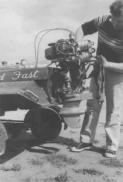
british anzani archive:





in 1958, and derivations of it kept me employed for the rest of my working life!
The most successful variant was undoubtedly the Dolphin Yacht Auxiliary, which
was produced in quite large quantities for several decades, and continues to this
day, in Bodmin. (See website - http://www.dolphinengines.co.uk/history.htm).
The one which pleased me the most however was the Hoganrood hydroplane
engine, which won the British ‘C’ Class National Hydroplane Championship’s in
1960 and 1961. The Hoganrood engine was a joint venture with fellow RCA
director, Benny Rood. Fitted with special water cooled cylinders with fancy
porting, and running on methanol, power output was raised to 45 bhp @ 8,500
rpm. There is a perverse pleasure in beating your old boss (Charles Harrison -
Ed) at his own game!
What was the Anzani factory like to
work in?
I can best describe the factory as a large walled
compound, containing a variety of very old and
sprawling buildings. These had been extensively
altered and added to over the years. The outside wall
was a truly substantial brick affair, and when the
equally massive gates were closed and locked there
would be little chance of breaking in.
Once through the gates one passed, (on ones right), a house like building which
was the reception, general and drawing offices and Charles Harrison’s office
too. There was a substantial open space in front of the factory proper. The
factory originally took the form of two long, low buildings arranged to the left and
extreme right of the compound. The large cobbled yard between these two
buildings (together with the space just mentioned) had once been used to
provide room for fairground roundabouts and rides to be assembled, out in the
open air. Long before I arrived, however, the yard had been roofed over with a
tall, mainly glass single story pitched roof, and it was into this brightly lit central
section that you would have entered the factory.
Looking to the right you would now see the outer walls of the original building,
although this had openings cut in it to provide access to what was now, the
machine shop. It was an extremely well equipped department although the
machinery was old. Many machines still displayed plates proclaiming them to be
the ‘Property of HM Government-On Loan For the Duration of the War’ and that
referred to the 1914/1918 unpleasantness! Many were flat belt driven from
lineshafts, and the general impression was not pleasant. The whole section
stank of cutting oil, and the noise was appalling. The most unpleasant noise
came from the cylinder honing machine which produced a shriek which was
almost painful to hear!
There were, of course no CNC machines in those days, but I can’t remember
anything at all that was the current state-of-the-art either, although some of the
capstan and turret lathes were quite nice. Nevertheless, all the machines were
in good shape and very well maintained, and in the hands of capable staff,
could and did turn out first rate components.
Looking left, you would have been shocked by what looked like a film set
depicting Hell.
This phenomenon was created because the whole of the outer wall of the
original long building had been removed on this side, and you would now be
looking directly into the assembly shop.
A very long, double sided work bench ran up and down the shop, and this was
plumbed in for gas. Every bench station had its own ‘fan tail’ burner, which was
intended to warm components such as pistons, to make them expand and so
facilitate assembly. These were all kept burning throughout the day, and when
viewed from the nice, bright, central shop it was impossible to see beyond this
wall of flames. The assembly shop being quite gloomy by comparison, it was
only just about possible to make out vague, shadowy figures moving about
beyond the flames! The effect was gruesome! On the left side of the assembly
shop were firstly, a small area sometimes used as a sort of showroom, and later
used by Richard Christoforides, then the ‘Repairs’ bench.
Next came the Millwright’s workshop, and then my Test House and ‘Inspection’.
Outside the test house were two horse shoe shaped bench areas. Of these, the
one on the left was where three fitters built the Super Singles. In the other the
Pilots were built. This was also the bench of the assembly shop foreman, Jock
Edwards. All other work was carried out on the main benches
(with the gas burners!)
Across the far end and closing in the central area, was the Stores, and beyond
and behind that, the Carpenters Shop. Here worked an artist in wood.
Apprenticed as a coffin maker, he would build a hydroplane for Charles, or an
export crate for engines, with equal ease. The whole factory was enhanced by
his splendid benches, duck boards, cupboards or whatever. Beyond his shop
was a bit of wasteland leading up to the back wall.
The central section of the factory was curious in as much as bits that should be
‘outside’, were often inside (gutters, drains etc). In the floorspace the Astra car
was assembled, as was the Iron Horse and Motor Hoe. Usually most of the
space was empty. High under the roof the finished engines were stored. They
had to be laboriously hauled up, on a special hoist. There was a sort of catwalk
and a wide platform too (accessible by iron steps) but it was hard work.
Harrison maintained that this was justified as the finished motors were stored in
the warmest, driest place in the factory, and they would never get damaged up
there! I have known occasions when many hundreds of engines were stowed
up there, as deliveries tended to be seasonal, whilst production remained
constant.
How big a company was it in those days?
Some 45 people were employed at that time. They were required to promise






